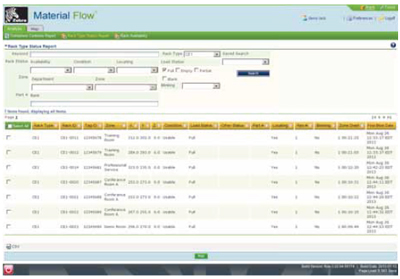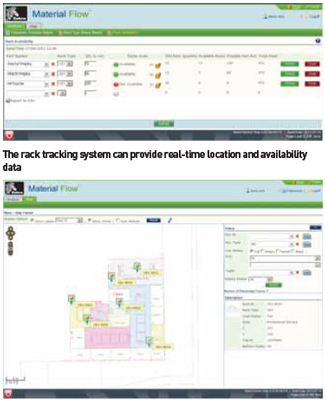Zebra Technologies product manager, John Fulton, discusses a rack tracking project with a major US vehicle manufacturer.
A major US OEM had a multi-million dollar problem with the purchasing and tracking of steel, reusable parts racks and wanted to be more efficient and save money. To address this they brought in Zebra Technologies to implement a tracking solution that utilises RFID tags. These tags send a signal every four minutes (as a standard setting), which is picked up by a receiving infrastructure at the OEM’s facility.
Based on which sensors receive the signal it is possible to triangulate the precise position of the rack within the facility.
“This provides an active, realtime locating system, with each rack having its own identity tag making it possible to track its movements and storage location within the plant,” explains product manager John Fulton.
The system is configurable so it can recognise a rack of a particular type (what type of load, fast or slow turn around) and its location in a specific production zone within the facility. It will also register how long that rack has been at that location (if it is a loading or unloading zone). This allows the system to automatically update the load status of the rack (i.e. full or empty) providing greater visibility to the usability of the rack fleet at any given time. “There are some features of the system that will allow us to capture the event even if it occurs in a short space of time such as under the standard four minute ‘blink rate’,” says Fulton.
Reusable racks are often built to hold one particular part; one plant recently visited had over 6,000 individual racks of 70 types. So what solutions does rack tracking offer?
Problem one: Despite their size, racks are difficult to find. Also, empty (or full) racks are not always placed in their designated storage areas, meaning delivery drivers spend time searching for racks, thereby reducing efficiency.
Tracking solution: Rack Tracking module* allows real-time location reports and mapping of racks, and configurable alerts when they go into areas where they are not supposed to be. *Requires RTLS infrastructure and VSS.
Problem two: Production needs to know how many empties they have to allow them to plan production runs. If there are not enough empties or they cannot be found, a production run can be cut short, resulting in excess tool changes and a loss in production time.
Tracking solution: Schedulers can run a report from the system to give them a real-time count of empty and useable racks on site.
Problem three: Daily rack inventories take time and resources and the counts grow ‘stale’ as time and production progress.
Tracking solution: Load status (full or empty) of racks can be automatically updated without user intervention when racks dwell in designated fill or empty zones.Reports can also be quickly run by rack type to get real-time counts.
Problem four: Maintenance and repair of racks that are damaged or other wise unusable is time-consuming. Individual damaged racks are difficult to find if they have not been brought directly to the repair area and notification of damaged racks is not always reliable.
Tracking solution: Notifications can be sent and daily reports can be run to find out which racks are in need of attention and where they are located. Specific racks can be located on a map to reduce search time.
Problem five: Tracking the receipt of new rack fleets from the fabricator is difficult and receipt of all racks by serial number is tedious and time consuming. Furthermore, once the racks are in service, it is almost impossible to audit all of them, making receipt confirmation of the entire order very difficult.
Tracking solution: When activated RTLS tags are affixed to the racks before shipment, the system can be queried to confirm whether racks have ever been “seen” on site.
The benefit to production is much better visibility of storage resources. Fulton offers a press shop as an example: “If the press shop is planning to begin a production run of a set number of panels they need to know if there are enough empty or undamaged racks, of the correct type on site, available to store the pressed parts. Otherwise costly delays can occur.”
Another issue relates to purchasing of large numbers of racks from the manufacturers. Often the new racks are delivered to the OEM’s facility in small batches and this can result in difficulty in accurately accounting for a complete order. “Clearly the OEM wants to know if the correct quantity and type of racks has been delivered,” says Fulton.
“The solution is to have the rack manufacturer apply RFID tags to the new units, so that when they arrive at the OEM’s facility they ‘blink’ to indicate the racks have arrived on site.”
This is a common cost issue with rack purchasing.
Once in use racks can become damaged and unusable.
This system also assists in the maintenance process, allowing the rack’s usability status to be flagged through the RFID tag. This can be done either at a remote PC workstation or by an operator responsible for the movement of the racks around the plant on a daily basis. “The flagging of a rack as damaged/unusable can also initiate communications to the maintenance department so action is taken to repair or replace the rack,” says Fulton.
It’s also quite common for functional changes to be made to the racks. The original configuration of the rack may not be suitable for later generations of parts for a given model or platform, so modifications are required. The system stores the rack’s revision level, ensuring that correct version of the rack is in use and provides information on the exact location, type and quantity of racking is available to production staff. Fulton explains: “If an operative is running short on a particular type of racking they are able to refer to a digital map locating additional (suitable) racks available in the facility and providing the quantity at that location”.
Expanding on its fi rst RFID project, Jaguar Land Rover (JLR) has implemented a vehicle tracking and management system (VTMS) for newly assembled vehicles at its Solihull facility in the UK. The company’s goal was to improve the efficiency of delivering vehicles to meet dealer orders. Basic requirements included improved visibility of all finished vehicles at the facility, including in the goods in/out yard, better co-ordination of post-assembly verification and test processes, and improved management of repair, containment and shipping zones.
JLR then extended its active RFID real-time locating system to its material replenishment activity, using the existing wireless infrastructure.
The implementation relies on reusable active RFID tags placed in vehicles as they leave the captive sequence of the assembly line. Each tag, in its bright yellow tag holder, is placed on the rear grab handle within the cabin to make identification easy. The tag’s identification number is connected to the VIN in JLR’s database.
The results have been increased production velocity, improved reporting and analytics, decreased inventory carrying and reduced labour needed to search for vehicles. The system also resulted in improved vehicle quality management, better space utilisation and a faster order to- cash cycle, with the ROI goal reached in nine months.
VTMS - How does it work?
VTMS is composed of three inter-related elements: location, business process modelling and mobile work force execution. The first element, provides an understanding of work cell or process area staging availability, telling you whether an area is occupied by a vehicle. Business process modelling then combines vehicle attributes, both physical and system-generated, such as quality concerns or test results, with a model of the process areas. This modelling provides the solution, with an understanding of what work is performed where, and in what sequence. The third element, mobile work force execution, then directs that movement request to the appropriate person or group.
Updating the rack’s other statuses can be done automatically as it is placed in a predetermined zone (a designated maintenance zone for example), however, this can also be updated manually, as was the preference of the US OEM working with Zebra. This customer requested automation of the ‘full or empty’ status indication while all other statuses were to be updated manually, but they can still be automatically updated states Fulton: “Using a series of ‘WherePorts’ the rack’s tag is automatically triggered as it passes into a different zone or reaches a particular station in the production process. This can then signal a change in status. As such the system can become self-correcting. “We can create and modify the rules of operation according to the customer’s requirements.”
Fulton also points out that simpler (and cheaper) passive label type tags could also be used. The company is currently working on integrating this tracking system with its existing stock replenishment software known as Zebra’s Material Flow software. The application of the rack tracking system can go beyond the production department. Fulton suggests that purchasing are interested in using it to establish type, quantity and location of racks across a number of facilities, even to the extent of which model/platform they have been specified for.






























